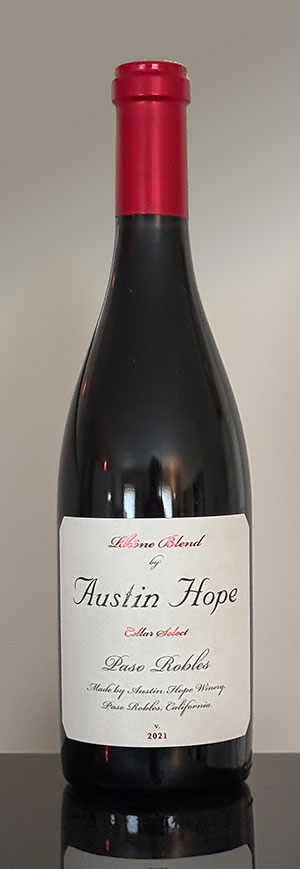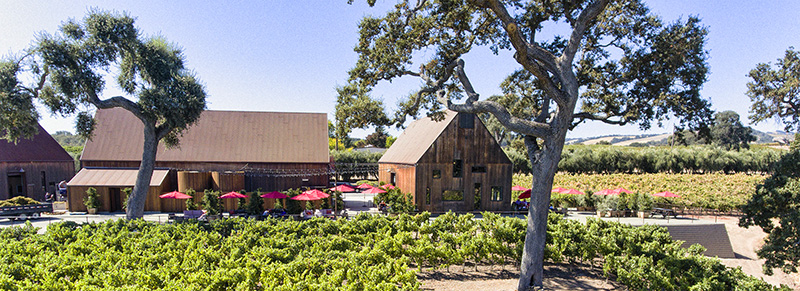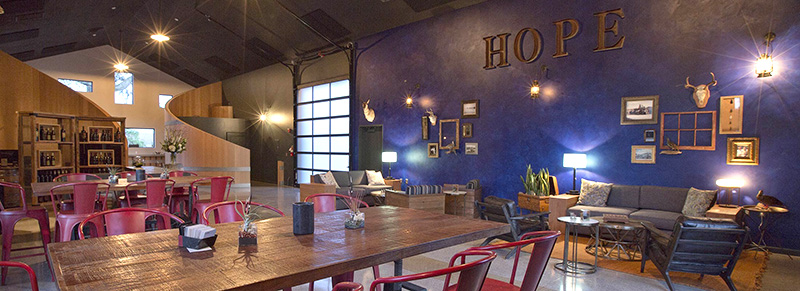
Click here for tasting notes.
Austin Hope Rhone Blend 2021
Chuck Hope and his wife Marlyn came to Paso Robles in California’s Central Coast in 1978 to farm, and eventually to start what would become Hope Family Wines. This early arrival put them on the forefront of the Central Coast becoming a world-class viticultural region. Initially, the Hopes planted apples and grapes in this then sparsely-populated area. Seeing the property’s potential for grape growing, Hope eventually replanted the apple orchards with grapes.
Throughout the 1980s and 1990s, the Hope family grew grapes for various wine producers. In the 1980s, the Wagner family, owners of Napa Valley’s Caymus Vineyards, turned to the Hope family to source Cabernet Sauvignon grapes for their Liberty School label. Thus began a long-lasting partnership between the two families.
Since that beginning, in Paso Robles specifically and throughout the region generally, Hope Family Wines has built long-standing relationships with over 50 growers. They coordinate with farmers to carefully limit crop yields to ensure concentrated flavors.
In 1996,the Hopes acquired Liberty School from the Wagners. Also in 1996, they launched Treana Winery with Chris Phelps serving as winemaker.
At about this same time, while studying fruit science at California Polytechnic State University, San Luis Obispo, the Hope’s son Austin spent some time working in Napa Valley under Caymus winemaker Chuck Wagner. This opportunity solidified his decision to pursue winemaking for his family. He became the head winemaker in 1998, and has held the position ever since. Since taking the lead as president and winemaker, Hope has helped Hope Family Wines grow from producing around 20,000 cases per year to over 300,000 cases per year.
In 2000, the family started a limited-production label, Austin Hope (surprise!), focused exclusively on Rhone varietals grown on the family’s estate vineyard, based on the calcareous loam, marine sediment, and dense clay soil of the Templeton Gap, which has the coolest microclimate in Paso Robles. It closely matches the climate of the Rhône Valley in France, as well as Napa’s acclaimed Rutherford district. The winery’s now-mature vineyards produce Cabernet Sauvignon, Syrah, Merlot, Mourvedre, and Grenache.
In 2008, the winery introduced Candor Wines, a multi-vintage label focusing on Zinfandel and Merlot wines with fruit sourced from family-owned vineyards in Santa Barbara, Paso Robles, and Lodi. It introduced its second multi-vintage blend, named Troublemaker, in 2010.


Hope Family Wines is committed to sustainable growing practices that promote vine health, improve wine quality, and ensure that growers remain profitable. Spraying is only done when necessary, and never after August first. The number of tractor passes is kept to a minimum, protecting the integrity of the root structures and avoiding compacting the soil. The winery works actively to promote best practices in the vineyards of growers they partner with. They use the self-assessment tools put together by the Wine Institute and the California Association of Winegrape Growers to gauge progress and identify areas for improvement over time.
Austin Hope Rhone Blend 2021
The grapes this red blend came from the Templeton Gap District AVA and York Mountain AVA on the western border of Paso Robles—two adjoining areas marked by a pronounced marine influence. The Templeton Gap District
enjoys warm days, cool nights and afternoon maritime breezes, and well-drained clay soils. Farther west, the York Mountain AVA is located just
seven miles from the Pacific Ocean at elevations reaching 1,500 feet. This cool-climate AVA receives twice the annual rainfall as Paso Robles proper. The conditions here include foggy mornings, brisk breeze,s and weathered sandstone soils reminiscent of beach sand.
The fruit was harvested in mid September, and clusters were hand sorted in the vineyard. The individual lots were destemmed and fermented separately in open-top stainless steel tanks for a period of 20 days, with daily pump overs for a balanced extraction of color, flavor, and tannin. The lots were aged separately for 23 months in French oak barrels (38% new, 33% twice used and 29% neutral). After final blending, the wine was racked to 40 percent new French oak barrels for an additional five months of maturation and integration before bottling.
This wine pours a medium dark garnet in the glass. The nose is very aromatic, predominantly blackberry. On the palate, the fruit, including blueberry, boysenberry and black cherry, is somewhat recessive. The profile is super dry, verging on bitter, backed up by very grippy tannins. ABV is 14.5%.
Back to blog posts: winervana.com/blog/
